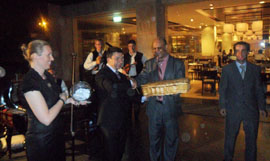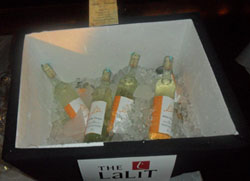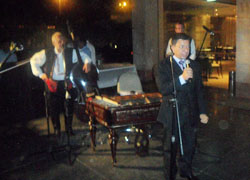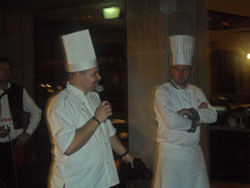Photos By:: Adil Arora
 Mention the country Czechoslovakia and my mind instantly throws up an image of a glass of Pilsner beer, historical castles and buildings amid picture postcard scenery. A glass of wine, perhaps? –Nope – even though I am a keen wine drinker, I find I tend to stay within the ambit of the top ten wine producing countries in the world. I actually didn’t know that Czechoslovakia produces wine till our Club President, Subhash Arora sent out an email to the members of the Delhi Wine Club about a Czech evening at the LaLiT ( #14/185). Mention the country Czechoslovakia and my mind instantly throws up an image of a glass of Pilsner beer, historical castles and buildings amid picture postcard scenery. A glass of wine, perhaps? –Nope – even though I am a keen wine drinker, I find I tend to stay within the ambit of the top ten wine producing countries in the world. I actually didn’t know that Czechoslovakia produces wine till our Club President, Subhash Arora sent out an email to the members of the Delhi Wine Club about a Czech evening at the LaLiT ( #14/185).
A little delve into history reveals that wine production has been part of the Czech agrarian economy since the 13th century. Unfortunately over the last couple of centuries, urbanisation and the advance of industrialization has offered alternative income sources to land owners and has prevented the Czech wines from exploiting the natural potential of their terroir. To give you an idea, there were some 700 hectares under wine cultivation in Prague in the 18th century, a figure which has dropped to just 11 hectares today. Nevertheless, some 19,000 hectares are under wine cultivation mostly in the sub-regions of Bohemia and Moravia with an average output of around 6 tons an acre .
Once one translates into English the local names of the grape varietals grown, it is apparent that the varietal mix is quite different from other wine growing nations with the usual suspects like Chardonnay, Cabernet Sauvignon etc being grown in very limited quantities. Interestingly, the varietals of Rhine Riesling, Muller –Thurgau and Pinot Gris account for well over 50% of the grapes grown in Czechoslovakia. Interestingly, the Czech’s bottle their wines in 500ml bottles rather than the 750ml which is by and large the international practice.
 Prime moved by the energetic Director of Czech Tourism in India, Radka Neumannova, the Czech festival is being rolled out across India with the idea of increasing awareness and improving the draw to Czechoslovakia from India as a tourist destination for our travel happy brethren. Banking on the fatigue factor of traditional European destinations for the Indian traveller, the Czechs are promoting their country as an alternative destination with the attractions of spa’s, wine and beer trails and a rich cultural heritage. It was with these thoughts in mind, HE Miloslav Stasek , Ambassador of the Czech Republic, inaugurated the festival. Prime moved by the energetic Director of Czech Tourism in India, Radka Neumannova, the Czech festival is being rolled out across India with the idea of increasing awareness and improving the draw to Czechoslovakia from India as a tourist destination for our travel happy brethren. Banking on the fatigue factor of traditional European destinations for the Indian traveller, the Czechs are promoting their country as an alternative destination with the attractions of spa’s, wine and beer trails and a rich cultural heritage. It was with these thoughts in mind, HE Miloslav Stasek , Ambassador of the Czech Republic, inaugurated the festival.
The setting for the evening was the alfresco area outside the 24/7 all day dining outlet of the LaLiT – a steady cool breeze and a four piece Czech music ensemble contributed to an environment eminently suited to tasting wine. The Czechs were showcasing the wines of the Prague Botanical Garden from two of its vineyards –the Svatá Klára (St. Claire) and Salabka –and had brought along 2 sommeliers to interact with guests and guide them thru the nuances of the wines on display.
Having attended many a wine tasting , I must give credit to Vivek Shukla , the GM of the LaLiT and his team for looking at the finer details of making a wine tasting experience all the more pleasurable. There were 10 wines on offer that evening and a dozen or so bottles of each of the wines were lined up in ice boxes, each with a descriptive label with the wines pedigree and its acidity, sugar and alcohol content clearly mentioned. So not only were the whites chilled and the reds cool (rather than at room temperature which is frequently the case with many hotels), but the wine drinker also had a visual opportunity to know what he was drinking and to compare the differences between the wines on these parameters.
 The Svatá Klára vineyard wines were predominantly white and skewed towards the off dry/semi-sweet category. The Rhine Riesling 2010 was a fresh crisp aromatic wine with a good balance of sugar and acidity which had our members going back for refills. A clone of the Riesling family , the Muller-Thurgau varietal was represented by the 2010 vintage but tasted a bit thin on account of it low sugar content at only 0.6 g/l despite some graceful citrus notes. The Pinot Noir Rose 2010 , the Riesling 2009 and the Pinot Gris 2009 with their sugar content’s in the range of 14to 26 g/l were well into the semi-sweet category and somewhat unfamiliar to our palates. The Svatá Klára vineyard wines were predominantly white and skewed towards the off dry/semi-sweet category. The Rhine Riesling 2010 was a fresh crisp aromatic wine with a good balance of sugar and acidity which had our members going back for refills. A clone of the Riesling family , the Muller-Thurgau varietal was represented by the 2010 vintage but tasted a bit thin on account of it low sugar content at only 0.6 g/l despite some graceful citrus notes. The Pinot Noir Rose 2010 , the Riesling 2009 and the Pinot Gris 2009 with their sugar content’s in the range of 14to 26 g/l were well into the semi-sweet category and somewhat unfamiliar to our palates.
The Salabka vineyard, which grows some 110 varietals for demonstration purposes, offered their Pinot Noir, Riesling and an interesting variety which I had not had before, the Neronet. Martin Beránek of the Salabka vineyard, was understandably proud of his Pinot Noir 2007 and Pinot Noir 2009 and mentioned his target of getting the harvested grapes from the vineyard to the cellar press within an hour so as to minimize the oxidation process. Both wines were soft and velvety with a plummy/cherry mouth though I felt the 2007 had more character as the acidity had become a bit smoother than the 2009 given two extra years in the bottle.
 The Czechs had done their planning not only on the wine front but also on the food front by flying in 2 chefs from Prague to create some Czech specialities which were served along with the normal buffet at the 24/7. The Cabbage soup, the dumplings and the Lamb Guláš were some of the outstanding creations of the chefs. I only wish I had asked for a glass of the Salabka Reisling 2010 to have with the dessert course to see how the wine with its 35 g/l sugar content performed as a dessert wine – I suppose I will have to wait for my first trip to Czechoslovakia to let you know!! The Czechs had done their planning not only on the wine front but also on the food front by flying in 2 chefs from Prague to create some Czech specialities which were served along with the normal buffet at the 24/7. The Cabbage soup, the dumplings and the Lamb Guláš were some of the outstanding creations of the chefs. I only wish I had asked for a glass of the Salabka Reisling 2010 to have with the dessert course to see how the wine with its 35 g/l sugar content performed as a dessert wine – I suppose I will have to wait for my first trip to Czechoslovakia to let you know!!
 Many thanks to Radka and Czech Tourism for giving our Delhi Wine Club members an opportunity to sample some of the more unknown yet palatable wines from her country. Radka also tells me that, despite the Czechs having the honour of having the highest per capita beer consumption anywhere in the world, there is a definite and noticeable increase in the appreciation of fine wine in her country with a new genre of wine bars, better stocked wine stores and many more restaurants with extensive wine lists providing greater choice . So all you wine drinkers, saddle up and head for Czechoslovakia on your next foreign outing !! Many thanks to Radka and Czech Tourism for giving our Delhi Wine Club members an opportunity to sample some of the more unknown yet palatable wines from her country. Radka also tells me that, despite the Czechs having the honour of having the highest per capita beer consumption anywhere in the world, there is a definite and noticeable increase in the appreciation of fine wine in her country with a new genre of wine bars, better stocked wine stores and many more restaurants with extensive wine lists providing greater choice . So all you wine drinkers, saddle up and head for Czechoslovakia on your next foreign outing !!
Arun Batra is a Delhi based food and wine enthusiast and a long time member of the Delhi Wine Club
Gallery |